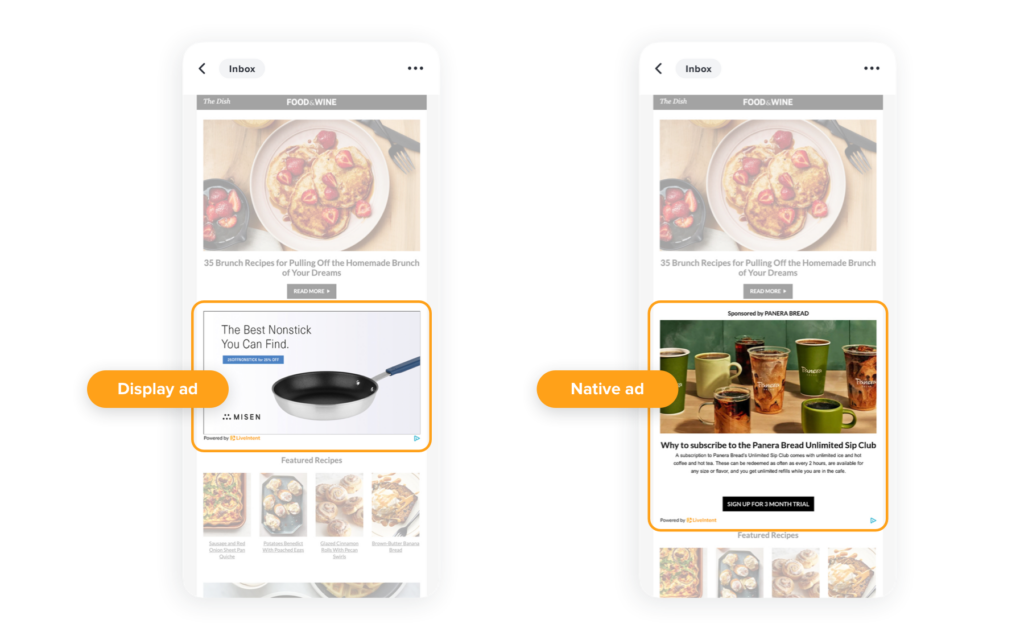Email Ads: How and why to advertise in email
Whether you’re an advertiser at an established brand or a growing one, reaching your audiences and driving product purchases is likely top of mind. But what’s top of mind for customers is their email. In fact, 1 in 3 millennials check their email as soon as they wake up and 55% of all Americans check their email before they go to work. So, what does this mean for you? It means that if you’re not already investing in email ads, now’s a good time to start.

In this blog post, you’ll learn about email advertising, what it is, why you should use email ads, and how you can get started with them.
Let’s dive in.
What is email advertising?
Email newsletter advertising is the process of creating and distributing paid content to targeted audiences in the email channel. Typically, a brand would pay to appear within another brand’s email to expand their audience reach and drive business. For example, a brand that sells pacifiers might pay to advertise on a parenting blog’s email newsletter.
Email advertising is different from email marketing, which is the process of delivering content via one’s owned email channel. For instance, a women’s apparel brand might distribute an email featuring their weekly sale items to their customer base. That’s email marketing.
Why use email ads?
Email ads can help brands drive business growth by:

- Getting in front of targeted, logged-in audiences: Since email is an opt-in channel, advertisers know they’re reaching engaged subscribers directly in their inboxes. Furthermore, by working with premium publishers with clean email lists, brands can tap into these audiences of real, engaged people — no bots or fraud to worry about.
- Cutting through the noise: On social networks, ads are squeezed into endless content feeds making them easy to scroll past. But, in the inbox, it’s just the reader and their open email. This gives you a one-on-one opportunity to reach and acquire high-value customers.
- Expanding your first-party data footprint: Advertisers need to build first-party data strategies to ensure business success. You can do that by investing in the email channel, which is rich with first-party data signals. Check out how American lingerie company, ThirdLove, does just that.
What kind of email ad formats are available to my business?
Brands can choose from different email advertising formats depending on their creative needs and business goals:

- Display ads: Display email ads are static images or GIFs, which can be inserted into newsletters just as they are on web pages. You can customize display ads for each email template and format them to various ad sizes, such as 970×550, 970×250, and 300×250.
- Native ads: Native email ads reflect the context and content of the email newsletters they’re in. This makes them less disruptive and more engaging than other types of ads.
Brands can buy ad inventory in email newsletters through a variety of buying methods, including:
- Open exchanges: Advertisers bid on inventory via demand-side platforms (DSP) and ad exchanges for programmatic, real-time placements in email newsletters.
- Curated deals: Brands purchase packages of audiences or email ads from premium publishers. LiveIntent offers three types packages: seasonal ad inventory, audience-based inventory according to certain attributes and behaviors, and content-based email ads for certain verticals.
- Direct-buy campaigns: Advertisers purchase email ad inventory directly from publishers on a one-to-one basis. Publishers create a contract for a set number of impressions and distribution timeframe.
LiveIntent offers a range of innovative tools to help brands advertise in email newsletters. Advertisers get exclusive access to our network of over 2,000 premium, brand-safe publishers and 290 million unique readers. And they can bid on email ad inventory through the LiveIntent DSP or our DSP partners, including DV360, MediaMath, The Trade Desk, and Verizon Media.
For more in-depth information about how to launch email ads and get started with newsletter advertising, check out this blog post.


